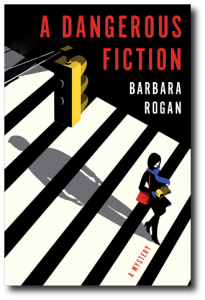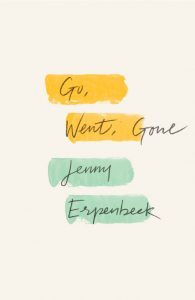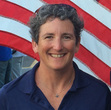Carol Newman Cronin's Blog, page 41
May 3, 2018
Book Review: A Dangerous Fiction
 Jo Donovan is the literary agent all writers want—well connected, hard working, and fair. Yet she’s still managed to make an enemy: a spurned writer, she assumes. So begins Barbara Rogan’s A Dangerous Fiction (2013).
Jo Donovan is the literary agent all writers want—well connected, hard working, and fair. Yet she’s still managed to make an enemy: a spurned writer, she assumes. So begins Barbara Rogan’s A Dangerous Fiction (2013).
I first discovered Rogan’s excellent writing through Rowing to Eden (1996), which was so engrossing I didn’t even notice that my plane landed forty-five minutes late. When I realized she was also the author of this mystery, which I’d noticed when it first came out but never read, I went right down to the library and checked it out.
The book takes us inside the publishing industry, which has changed dramatically since Rogan published her first book in 1982. It starts off surprisingly slow, with an agency monthly meeting, then quickly gathers steam; we meet a threatening writer (nicknamed Sam Spade) who stalks Jo, trying to get her to read his manuscript (the author’s secret fantasy). We find out that another author she doesn’t like wants to write a biography of Jo’s famous author husband, who died quite suddenly a few years ago. Slowly but surely, Rogan shows us how much Jo, our only eyes into her world, has missed seeing—and that leads us to the surprise ending. As a reader, I trusted that one of the many characters I’d already met was the bad guy, but all of them seemed too “nice” or “normal” to be the actual suspect. Once I learned the “truth,” it made me want to read the book all over again, to see how many clues I’d missed while gobbling up the story.
When I did go back to the beginning, I realized there were two reasons why I wasn’t particularly caught up by the first few chapters.
The prologue, which made complete sense after the fact but was too subtly crafted to have any useful impact up front. An editor I respect says, “If you have a prologue, don’t send it to me. Send me the first 5 pages of Chapter 1 instead.” Perhaps that has made me too judgmental of prologues, but this one was a perfect example of excellent writing that doesn’t accomplish anything—except to remind us that the author already knows what’s going to happen.
The opening scene spends too much time setting up “ordinary” and introduces us to too many characters. Another editor I respect says (about opening scenes), “Weave in only enough character and world building to help the reader understand what’s happening and what’s at stake.”
Don’t get me wrong; I really enjoyed this book and I recommend it to anyone who enjoys mysteries about “real” people. I’m just surprised by the pacing issues, because usually the first fifty pages of a story get the most attention from both author and editor. This one began flat and then picked up speed, especially compared to the steady strokes of Rowing to Eden. It makes me wonder if Rogan’s earlier work (which provided such an engrossing distraction from the realities of air travel) received more editing attention, way back in 1996, than any publication could possibly expect by 2013.
You can find out more about Rogan and her eight books on her website—or just get thee to your nearest library, and take one along on your next flight.
April 26, 2018
Transitions without Thought
Imagine how loudly a baseball manager would complain if the bases were brought in closer whenever the wind died. Or if the outfield grass grew hummocks whenever the sea breeze piped up? Other sports don’t tolerate field of play variations, so other athletes don’t have quite so many transitions to make.

The number of adjustments in even the shortest sailboat race is colossal—even for the last place team. In any sensitive race boat, a puff two knots stronger than the regular breeze will require a change to crew location and sail shape; it may also demand a change in tactics or strategy. That’s why one of the commonalities I found while interviewing 18 Olympic sailing medalists was the ability to make such transitions without thought. Thanks to all those hours of training, bodies are moved and lines adjusted without the athlete even being aware of the change.
These transitions are part of what makes the sport of sailing so much more fun to do than to watch. Brains constantly calculating the risk and reward of each possible maneuver and decision just don’t make good TV; there’s no way to communicate all that mental activity to a viewer.
Off the race course, we use these skills to adjust to life changes. Career moves; the different roles we play; tweaking habits as our bodies age… all require that same ability to adjust to whatever is thrown at us. And just like many of those race course decisions, it’s usually only in hindsight that we realize how well (or how badly) we dealt with it all. The key is to make transitions instinctively, just as we learned from all that sailing practice.
Change is the only constant, in life as well as in sailboat racing. All we can do is adjust our sails and try not to think about it too much, just like all those medal-winning sailors.
April 19, 2018
Writing and Editing with Latitude
There are some words that crop up across a strangely wide range of specialties, and my all-time favorite has got to be “latitude.”  Depending on context, it can mean so many different things:
Depending on context, it can mean so many different things:
Specific location on the globe, measured north or south of the equator
Climate or region
Scope for freedom of action or thought
Dig even deeper and the word crops up in photography, specifying “the range of exposures for which an emulsion or printing paper will give acceptable contrast.”
It recently occurred to me that latitude is an excellent goal for writing and editing as well. I’ve got a mean eye for typos, but I find it harder to see what “should” be on the page without getting caught up in the details of sentence structure and word choice. The best writing tells the big picture story well, while carefully choosing specific details that enhance rather than distract from that story. The best editing finds the story’s true north, and then aligns all the details to point in that direction. This forest-and-trees approach is a kind of latitude, a range of exposures that leads to the best balance between the two.
Editors and agents all want to understand both the forest and trees of a manuscript in the shortest amount of time possible, which is why many ask for a synopsis (forest) as well as a writing sample (trees). It’s not surprising so many writers have difficulty writing a killer synopsis; the closer we are to the work, the harder it is to step away and see it from 10,000 feet.
Writing and editing with latitude. Something to shoot for, anyway.
April 12, 2018
Muse 2018: April Confluence
Apparently, the writer’s conference Muse and the Marketplace is usually in May.  For 2018 it took place April 6-8, and for this first-time attendee the timing was perfect. After all, what better time of year to breathe new life into writing and publishing goals than the startling contradictions—snow-showers, flowers—of an early spring weekend in Boston?
For 2018 it took place April 6-8, and for this first-time attendee the timing was perfect. After all, what better time of year to breathe new life into writing and publishing goals than the startling contradictions—snow-showers, flowers—of an early spring weekend in Boston?
For visitors from outside New England, it probably still seemed like winter. For locals, the damp gray-on-gray outside created a cozy snow day-sleepover atmosphere inside. And for such a gathering of deep thinkers, how a city on the North Atlantic wakes up from its long winter’s nap—one step forward, two steps back—made an apt metaphor for the erratic agony and ecstasy of writing, editing, and publishing.
“The Muse,” as it’s known to insiders, offers something to writers at all points on their journey, which explains the whopping 800 attendees. There were sessions on everything from sentence-crafting to “Saying the Unsayable.” Experts talked us through author platforms, query letters, and the changing face of publishing. For writers who’d signed up in advance, there was a very well-organized (and sold-out) “Manuscript Mart,” where one-on-one meetings with agents and editors offered personalized feedback.
As an actively querying author, my goal going into the weekend was to shake hands with as many agents as possible. Three days later, my biggest takeaway was quite unexpected; spending time in the same room with someone can provide many lessons, even without a handshake. Listening in as four agents dissected other people’s first pages, I found myself reversing roles; mentally sending apologetic emails explaining that, sadly, they were “not a good fit for my writing goals.” Spending time with other authors, I remembered that each of us has a distinct story to tell. Best of all, chance meetings led to friendships that will, I predict, be both enlightening and entertaining for many years to come.
I’ve been to writer’s conferences before, but Muse18 was something special. It supplied the best of college (directed learning, impromptu hallway chats) without much of the worst (cliques, feeling like a dweeb for going to bed before midnight). Yes, agents tended to share breakfast with other agents (and we authors gathered the wagons as well), but everyone was quite approachable; I never felt like I couldn’t interrupt if I had something important to share. The atmosphere was supportive, friendly, and outgoing (though also—at least for this country mouse—more crowded at times than I preferred).

Maybe Muse “should” be in May, but this year’s version came at the perfect time for me. Eleven months ago, I wouldn’t have even known the words for what I didn’t know. A month from now, the weather will be better for sailing than butt-in-chair-learning. Muse met me where I was and helped me navigate down the publishing path, at a far more predictable forward pace than Boston’s spring weather. And that (like that less-traveled road, in that yellow wood) has made all the difference.
April 5, 2018
Podcast: Solving the (Sailing) World’s Problems
I’ve admired Andy Rice’s endeavors across the Pond for years; his SailJuice blog provides racing tips and news from “the sharp end of sailboat racing.” So when he asked if I’d do a podcast to explore whether Olympic medalists are born or made, there was only one right answer. “Of course!” I wrote back.

That led to a free-flowing 45 minute Skype call on a wide-ranging set of topics: Olympic sailing (I’d recently read his January Seahorse article about the World Sailing annual conference; he hadn’t yet read mine on What Makes an Olympic Champion); the SailJuice Winter Series and the fantastic clothing that makes it bearable (I’m looking at you, Zhik); and, of course, how to make a living as a sailing-obsessed writer.
After a nice gam, we decided it was time to get down to podcasting and Andy ended the call. The plan was to call me back right away and start recording.
Then the power went out.
Rhode Island was in the middle of yet another Nor’easter, and for whatever reason the local electric grid picked that particular moment to shut down. Once I explained (via cell phone), we quickly rescheduled. A few days later, we had a great call that you can listen in on here.
Although the sound of my own voice makes me cringe, I was honored to join the ranks of sailing legends like Tom Burton, Ian Walker, and Nathan Outteridge (I interviewed Nathan myself only six months ago). I also really enjoyed the chance to speculate about what I would’ve done differently if I’d known Athens 2004 was going to have two days of really big breeze. (Though twing management would’ve taken away the sea stories that led to a 2014 writing award for Olympic Broach: The No Good Very Bad Windiest Day.) Talking about Olympic sailing with another enthusiast remains one of my greatest pleasures, and the forty-four minute call sped by faster than expected.
I like to think that sharing perspectives about sailboat racing from our two sides of the Pond will help bring about world peace… but whether or not that actually comes to pass, podcasting is a exciting way to share content. I look forward to solving more of the world’s problems (at least the sailing ones) with Andy in future episodes; meanwhile, you can get updates directly from him by signing up for his free newsletter.
March 29, 2018
What Makes a Book Memorable?
I read almost every night before going to sleep. Some books I put down and don’t think about again until twenty-three hours later. Others have characters so bland, I have to relearn their names every evening.
Once in a great while, a book will stay with me between bedtime reading sessions. The characters walk beside me while I go about my routine, like friends I’ve recently visited. (If I were a New York City literary agent, this would be where I’d mention missing my subway stop.)

It’s the memorable books that make my annual holiday book lists, because they take me out of my own world and into their own—not just while I’m actively engaged with their pages, but while I’m walking or driving or doing the dishes. These books whisper in my ear, making me feel like I’ve stayed away too long—and then allow me to pick up again right where I left off. Unlike the 24 hour news cycle, or anything else on a screen, their pages will be the same no matter how long I stay away. I read mostly fiction, but well-written non-fiction can cling too.
The best books are also the hardest to parse. The writing slips by unnoticed, a self-driving vehicle that propels the story to its next destination. Occasionally I will pause to appreciate a particularly lovely sentence, but mostly my eyes rush forward to find out what happens next. (If it’s a truly memorable book I’ll start over again from the beginning right away, to study how the author achieved that perfect level of detail and tone, all in the right order.)
It’s much easier to spot what keeps books from being memorable. If I’m editing as I read, the self-driving car needs re-programming. Recently I read a book that started off really well and was almost as good in the last quarter. In between was a muddle of distracting background information (in one jaw-dropping instance, the same description appeared word for word on two separate pages). I know that already! I silently shouted at the page, frustrated with how much better (and shorter) the 400-page book could’ve been. Maybe that middle third was edited on a Friday or Monday?
I made it to the end, and I’m glad I did. Despite its heavy-handedness, it still checked off several items on my list of what makes a book memorable:
Characters feel real—though they don’t have to be people I would hang out with in real life.
Setting details include just enough so I can “see” where I am, it but not so much it bogs down the story.
There has to be a question. Or even better, several questions. And they have to be answered, but not too predictably or too fast.
Like setting, formatting should not distract. I shouldn’t be thinking about why a designer chose a particular font or added spaces between paragraphs instead of indenting the first line.
Got something to add to this list, or a book you couldn’t put down? Please share in the comments below. Meanwhile, I’m off to the bookstore, in search of my next memorable read.
March 22, 2018
What Makes an Olympic Champion?
The March 2018 issue of Seahorse Magazine includes my first-ever full length article in that excellent publication. Entitled “What does it take…”, the subhead reads, “US Olympian Carol Cronin has recently spent a considerable amount of time grilling some likely suspects.” True enough!
Apparently some of my “victims” define “Olympic Champion” as gold medalist. To me, it’s any medalist, but I’m glad that Seahorse came up with a different title to dodge the issue. I’m including the first three paragraphs here as a teaser. To read all four pages, subscribe to Seahorse; there’s a ton of other great stuff about sailing, all bracketed with dry British humour.

Each quadrennium Olympic programmes spend the equivalent of a small country’s GDP honing their best medal prospects, and still we don’t really know what makes an Olympic champion. Is it nature: the dream that burns brighter/starts earlier? Or is it nurture: parental guidance, federation support and a well-defined pathway?
Since my own disappointing finish at the 2004 Olympics I’ve thought quite a lot about the vagaries that make it so cursedly hard to win a medal in sailing. All Olympians are driven, hardworking and focused on a specific lofty goal. All have trained for thousands of cold, wet hours, in search of an elusive speed edge (Kiel, anyone?). Only a few step on the podium.
Maybe, by taking advantage of sailors’ accessibility (leaping between all the vague connections), I could interview a bunch of recent medal winners. Maybe linking their stories together would help us see a pattern and figure out what enabled them to rise above an already elite group. Maybe.
To read on, subscribe to Seahorse
March 15, 2018
Dare to Fail: Plotting the next Novel
Those of you who follow this blog know I don’t do outlines. In the biz, the term for this approach is “pantser,” as in: writing by the seat of my pants. Authors who write from outlines are called “plotters,” so it’s not uncommon to be asked, “Are you a pantser or a plotter?” We all know which tendency comes most naturally to each of us.
Pantsing is more creative. Plotting is more efficient. And of course, the grass always looks greener at the other end. If I were better at outlining, I wouldn’t have so much cleaning up to do.
When I start writing a new story, I have a strong sense of scene and a couple of new voices chattering away inside my head. What I don’t yet know is what’s going to happen next, and how the story will end; that’s still hidden off in the fog of what’s to come.
The only way I’ve ever been able to find out what happens next is to follow the breadcrumbs dropped by my characters. Planning a story makes the voices in my head go silent. But wouldn’t it be great to know where I’m going before I set off?
Test driving a hybrid
Other pantsers have learned how to outline, and many writers use a hybrid approach designed to provide structure without silencing the voices. So with my next project, I’m going to sidle a little closer to plotting. Let the characters speak up, get to know them a little… and then try to work through an outline. That’s got to be more efficient than following them all down so many blind creeks on the way to The End.
Three years of neglect didn’t scare away the last cast of characters, so I’m hopeful the new set will work with me on this. After all, they want their story told just as much as I want to tell it. The question is whether they can figure out how to tell rather than show; how to summarize rather than give every single detail and count on me to edit out what’s not needed.
There’s only one way to find out, and here at the heady beginnings of a new story, it sure seems like daring to fail is the next logical step in this author-journey.
March 8, 2018
Scrivener: The Right Tool for any Writing Job
A recent canvas project included what are called “common sense” fasteners, which required a cutting tool I didn’t have. So I bought one, even though I may never use it again. Good investment? I believe so; I could’ve done the job without the tool, but it wouldn’t have come out as well—and it would’ve taken longer. Tools that make our jobs easier (even our side jobs) give us the gifts of time and reduced frustration.
For writing, Scrivener is that tool I can no longer do without. Quite simply, it enables my creativity. Structured just enough to keep the stray bits and bobs of writing from getting lost, it’s also flexible enough to make it possible for anyone—and I mean anyone—to improve approach and organization, no matter where you find inspiration or how you define “done.” If I hadn’t written my current WIP in Scrivener, I couldn’t have picked it up and carried it across the finish line after deserting it for almost three years.
I started using Scrivener in 2010 and quickly grew to appreciate its “mind-expanding potential,” though it failed to make my characters any more obedient. When I decided to upgrade to Scrivener 3.0 in the fall of 2017, I couldn’t figure out how to apply a coupon code from my previous purchase, so I paid full price, again: $45. I was quite happy to do so, because it’s such a damned good deal. How many tools do we say that about?
One cool new feature is the ability to color-code text files and then track them visually, which makes it possible to see the “forest” of a novel as never before. Below are the four parts of the latest book, color-mapped by point of view. Each box represents a chapter. Thanks to this visual comparison, I can see that the first chapters follow the original vision (to present each point of view in order). The rest of the book is less regimented, once I realized that some characters needed more page time than others. It also made me realize that Part 2 is almost twice the length of the others (though this cropped screenshot doesn’t show that). I don’t yet know what I’ll do with all this information, but being able to see the big picture is extremely valuable to understanding the book’s structure.
Tools that make jobs more efficient are always worth it; tools that expand our possibilities are priceless. Scrivener does both, so I’m very glad to see it finally gaining some traction in the writing world. No matter what kind of writing you do, buy this software. You’ll save money, time, and help your imagination soar.
March 1, 2018
Book Review: Go, Went, Gone
 I stumbled onto Go, Went, Gone, a novel by Jenny Erpenbeck (and translated from German by Susan Bernofsky), thanks to a review in the New Yorker, and I’m so glad I did. The unassuming but important story dropped me into a world I’d heard about only on the news and made it personal, something fiction can do so well in the right hands.
I stumbled onto Go, Went, Gone, a novel by Jenny Erpenbeck (and translated from German by Susan Bernofsky), thanks to a review in the New Yorker, and I’m so glad I did. The unassuming but important story dropped me into a world I’d heard about only on the news and made it personal, something fiction can do so well in the right hands.
The narrator, Richard, is a recently retired academic. He lives in Berlin, east of a wall that is no longer there. His wife has died, and retirement brings nothing but loneliness; “As of today, he has time—plain and simple.” A few pages later, we learn that “Richard really will have to be careful not to lose his marbles.” Trivial details paint a picture of a mind desperate for a new focus—a lawnmower blade sharpened, an unwavering breakfast and dinner routine—until his curiosity leads him to interview African asylum-seekers who are camped out on the Alexanderplatz, a square in the middle of Berlin.
Like Richard, the refugees want to work but can’t. They are stuck in a limbo caused by European Union law, which states that refugees can only work in the country where they first register. For these men, that’s Italy, where there are no jobs. Germany needs workers, but they are not allowed to register there.
As the story unfolds, Richard discovers more and more commonalities between himself and these men, despite all the superficial differences (country of origin, skin color, financial status). He also discovers how far apart their worlds are when he tries to explain to one of the men about the Berlin wall.
“Did you know that this used to be the East?”
Osarobo shakes his head. “East?”
Probably this isn’t the right way to ask this question when speaking to a person from Niger.
“Did you know that there used to be a wall in Berlin that separated one half of the city from the other?” he asks.
“I don’t know.”
“It was built a few years after the war. Did you know there was a war here?”
“No.”
“A world war?”
“No.”
“Did you ever hear the name Hitler?”
“Who?”
“Hitler. He started the war and killed all the Jewish people.”
“He killed people?”
“Yes, he killed people—but only a few,” Richard says quickly, because he’s already feeling bad about getting carried away almost to the point of telling this boy, who’s just fled the slaughter in Libya, about slaughter that happened here. No, Richard, will never tell him that less than a lifetime ago, Germany systematically murdered so many human beings. All at once he feels deeply ashamed, as if this thing that everyone here in Europe knows is his own personal secret would be unreasonable to burden someone else with. And an instant later, just as forcefully, Richard is seized by the hope that this young man’s innocence might transport him once more to the Germany of before, to the land already lost forever by the time he was born.
I’ve added quote marks for clarity here, but the lack of them in the novel removes barriers between speech and thought. It’s easy to follow Richard’s rambling mind as it jumps from past to present and back again.
My only criticism is Richard’s obsession with a former lover, which doesn’t seem important to the story, but perhaps it is a way of showing Richard as flawed right from the beginning. All the characters are imperfect, but somehow hope shines through the quiet desperation and inhuman treatment of the immigrants’ lives. It is a peek into a Germany I had never seen before.
I’d also never heard of Jenny Erpenbeck, so now I’m going to seek out her previous books—if only for the inspiration to make every word and sentence and scene of my own books carry as much weight as her translated ones. As reviewer James Wood wrote in A Novelist’s Powerful Response to the Refugee Crisis, Erpenbeck’s “task is comprehension rather than replication, and she uses a measured, lyrically austere prose, whose even tread barely betrays the considerable passion that drives it onward. (Susan Bernofsky deserves immense credit for bringing this prose to us in English.)” Agreed.



